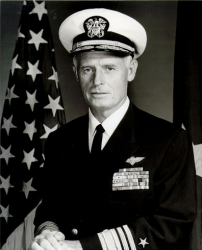
 |
|
|
||
|
William Floyd Bringle |
||||
|
Engagements: • World War II (1941 - 1945)• Vietnam War (1960 - 1973) |
||||
| Biography: | ||||
|
William Floyd Bringle Admiral, U.S. Navy William Floyd Bringle was born on 23 April 1913 in Covington, TN, the son of William F. and Lota Smith Bringle of Covington. He attended the Byars-Hall High School and Columbia Military Academy before his appointment to the U.S. Naval Academy. Graduating in June 1937, he was commissioned as an Ensign. During his career, Bringle served in numerous sea and shore assignments. His first was aboard the USS Saratoga (CV-3) in the gunnery, communications and engineering departments as a junior officer until 1940. Reporting to the Naval Air Station Pensacola for flight training, he was designated a Naval Aviator in December 1940. World War II In January 1941, he served as senior aviator aboard the USS Milwaukee (CL-5), and he eventually became Commanding Officer of Cruiser Scouting Squadron TWO, operating on the USS Omaha (CL-4) and the USS Savannah (CL-42). From September to November 1943, he trained at the Naval Air Station Melbourne and in December, formed the first Observation Fighting Squadron (VOF-1) during World War II. He commanded the squadron throughout the period of hostilities, and was awarded the Navy Cross, "For extraordinary heroism in action against enemy forces during the Allied Invasion of Southern France in August 1944." Bringle also received the Croix de Guerre with Silver Star from the Government of France for his part in the invasion. Reassigned to the Pacific war again, Bringle and squadron embarked in the USS Wake Island (CVE-65) and later the USS Marcus Island (CVE-77). While under his command, the squadron participated in strikes against enemy held installations in Leyte, Luzon, Iwo Jima, Sakishima Gunto, Nansei Shoto area, Okinawa and many other Pacific islands. His squadron contributed materially to the success of these combat operations in the performance of its primary function of spotting for naval gunfire and close air support of ground forces in repeated bombing and rocket attacks against enemy troops and installations. Post-War Service Through Early 1960s After World War II, from October 1945-46, he was the Air Group Commander, aka: "CAG" of Carrier Air Group Seventeen and, when detached, he returned to the Naval Academy for duty as a Battalion Commander. He remained there until June 1948. Returning again to sea, Bringle filled the post of Commander, Carrier Air Group One aboard the aircraft carriers USS Tarawa (CV-40) and USS Philippine Sea (CV-47). From 1950-52, he served as a member of the Superintendent's Staff at the Naval Academy. The next year, as a student, he attended the Naval War College at Newport, RI. Another 18 months of sea duty as Executive Officer of the USS Hornet (CV-12), 1953-54, was alternated with 2½ years of shore duty as head of the Operational Intelligence Branch of the Chief of Naval Operations, and as the Personal Aide to the Secretary of the Navy. In 1957, Bringle assumed command of Heavy Attack Wing Two, operating A3D Skywarrior bombers in the Pacific. He served in this command until July 1958, when he became the Commandant of Midshipmen at the Naval Academy. In May 1960, Bringle received orders designating him as the Prospective Commanding Officer (PCO) of the Navy's newest attack carrier, the USS Kitty Hawk (CV-63), building at the New York Shipbuilding Corporation of Camden, NJ. He became the first Commanding Officer on her commissioning day, 29 April 1961. In June 1962 he was assigned to the Office of the Chief of Naval Operations, where he served as Assistant Director of the Aviation Plans Division until January 1963, when he was designated the Director of that Division. Flag Officer Assignments On 6 April 1964, he assumed command of Carrier Division Seven. In addition to commanding Carrier Division Seven, Rear Admiral Bringle served as Commander Task Group 77.6, during the period of 29 March to 29 June 1965 and as Commander Task Force Seventy Seven (CTF-77) from 28 May to 27 June 1965. For service in these capacities, he was awarded the Legion of Merit with Combat "V". In July 1965, he was ordered to the Staff of Commander-in-Chief, U.S. Pacific Fleet, where he assumed the Office of Deputy Chief of Staff for Operations and Plans. Vice Admiral Bringle was Commander, U.S. Seventh Fleet during 1967-70. On 1 July 1971, Bringle was promoted to the four-star rank of Admiral and assigned as Commander-in-Chief, U.S. Naval Forces Europe (CINCUSNAVEUR). Admiral Bringle retired from the Navy in 1974. Medals and Awards Navy Cross Death and Burial Admiral Bringle died on 19 March 1999 at Rancho Santa Fe, CA, and is buried at the U.S. Naval Academy Cemetery in Annapolis, MD. |
||||
| Honoree ID: 468 | Created by: MHOH | |||
Ribbons
Medals
Badges
Honoree Photos
 |  |  |
 |  |
 |


